Abstract
Purpose
The accuracy of intertrochanteric fracture classification is important; indeed, the patient outcomes are dependent on their classification. The aim of this study was to use the AO classification system to evaluate the variation in classification between X-ray and computed tomography (CT)/3D CT images. Then, differences in the length of surgery were evaluated based on two examinations.
Methods
Intertrochanteric fractures were reviewed and surgeons were interviewed. The rates of correct discrimination and misclassification (overestimates and underestimates) probabilities were determined. The impact of misclassification on length of surgery was also evaluated.
Results
In total, 370 patents and four surgeons were included in the study. All patients had X-ray images and 210 patients had CT/3D CT images. Of them, 214 and 156 patients were treated by intramedullary and extramedullary fixation systems, respectively. The mean length of surgery was 62.1 ± 17.7 min. The overall rate of correct discrimination was 83.8 % and in the classification of A1, A2 and A3 were 80.0, 85.7 and 82.4 %, respectively. The rate of misclassification showed no significant difference between stable and unstable fractures (21.3 vs 13.1 %, P = 0.173). The overall rates of overestimates and underestimates were significantly different (5 vs 11.25 %, P = 0.041). Subtracting the rate of overestimates from underestimates had a positive correlation with prolonged surgery and showed a significant difference with intramedullary fixation (P < 0.001).
Conclusions
Classification based on the AO system was good in terms of consistency. CT/3D CT examination was more reliable and more helpful for preoperative assessment, especially for performance of an intramedullary fixation.



Similar content being viewed by others
References
Dimai HP, Svedbom A, Fahrleitner-Pammer A, Pieber T, Resch H, Zwettler E, Chandran M, Borgström F (2011) Epidemiology of hip fractures in Austria: evidence for a change in the secular trend. Osteoporos Int 22:685–692. doi:10.1007/s00198-010-1271-9
Hornby R, Evans JG, Vardon V (1989) Operative or conservative treatment for trochanteric fractures of the femur. A randomised epidemiological trial in elderly patients. J Bone Joint Surg Br 71:619–623
Handoll HH, Parker MJ (2008) Conservative versus operative treatment for hip fractures in adults. Cochrane Database Syst Rev 3:CD000337. doi:10.1002/14651858.CD000337.pub2
Anglen JO, Weinstein JN, American Board of Orthopaedic Surgery Research Committee (2008) Nail or plate fixation of intertrochanteric hip fractures: changing pattern of practice. A review of the American Board of Orthopaedic Surgery Database. J Bone Joint Surg Am 90:700–707. doi:10.2106/JBJS.G.00517
Aros B, Tosteson AN, Gottlieb DJ, Koval KJ (2008) Is a sliding hip screw or im nail the preferred implant for intertrochanteric fracture fixation? Clin Orthop Relat Res 466:2827–2832. doi:10.1007/s11999-008-0285-5
Parker MJ, Handoll HH (2005) Gamma and other cephalocondylic intramedullary nails versus extramedullary implants for extracapsular hip fractures in adults. Cochrane Database Syst Rev 4:CD000093. doi:10.1002/14651858.CD000093.pub3
Kaplan K, Miyamoto R, Levine BR, Egol KA, Zuckerman JD (2008) Surgical management of hip fractures: an evidence-based review of the literature. II: intertrochanteric fractures. J Am Acad Orthop Surg 16:665–673
Burstein AH (1993) Fracture classification systems: do they work and are they useful? J Bone Joint Surg Am 75:1743–1744
Whitelaw GP, Segal D, Sanzone CF, Ober NS, Hadley N (1990) Unstable intertrochanteric/subtrochanteric fractures of the femur. Clin Orthop Relat Res 252:238–245
Colton CL (1991) Telling the bones. J Bone Joint Surg Br 73:362–364
Jensen JS (1980) Classification of trochanteric fractures. Acta Orthop Scand 51:803–810
Gehrchen PM, Nielsen JO, Olesen B (1993) Poor reproducibility of Evans’ classification of the trochanteric fracture. Assessment of 4 observers in 52 cases. Acta Orthop Scand 64:71–72
Chapman CB, Herrera MF, Binenbaum G, Schweppe M, Staron RB, Feldman F, Rosenwasser MP (2003) Classification of intertrochanteric fractures with computed tomography: a study of intraobserver and interobserver variability and prognostic value. Am J Orthop (Belle Mead NJ) 32:443–449
van Embden D, Rhemrev SJ, Meylaerts SAG, Roukema GR (2010) The comparison of two classifications for trochanteric femur fractures: the AO/ASIF classification and the Jensen classification. Injury 41:377–381. doi:10.1016/j.injury.2009.10.007
Landis JR, Koch GG (1977) The measurement of observer agreement for categorical data. Biometrics 33:159–174
Fung W, Jonsson A, Buhren V, Bhandari M (2007) Classifying intertrochanteric fractures of the proximal femur: does experience matter? Med Princ Pract 16:198–202. doi:10.1159/000100390
Savolaine ER, Ebraheim NA, DeTroye R, Jackson WT (1992) Three-dimensional CT reconstruction for assessment of Pipkin fracture-dislocations of the hip. Orthopedics 15:49–51
Acknowledgments
We thank Dr. Liang and Dr. Tao for participating in this study. We thank Prof. LiXing Zhu and Prof. WangLi Xu for statistical consultation and insightful suggestions on this work. We thank Xu Guo, Tao Wang and ZhengHui Feng for assisting in preparation of this manuscript.
Conflict of interest
The authors declare that they have no conflict of interest.
Author information
Authors and Affiliations
Corresponding authors
Rights and permissions
About this article
Cite this article
Shen, J., Hu, F., Zhang, L. et al. Preoperative classification assessment reliability and influence on the length of intertrochanteric fracture operations. International Orthopaedics (SICOT) 37, 681–687 (2013). https://doi.org/10.1007/s00264-012-1748-6
Received:
Accepted:
Published:
Issue Date:
DOI: https://doi.org/10.1007/s00264-012-1748-6




